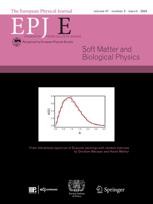A metareview of active matter research
This paper presents a ‘review of reviews’ of the rapidly growing and diversifying field of active matter research, providing a valuable overview of the field as a whole
New York | Heidelberg, 15 April 2025
 Active matter is a term describing systems of particles which harvest the energy in their surrounding environment, usually to propel themselves forward. With examples including flocks of birds, bacteria colonies, and swimming microrobots, active matter can show deeply complex behaviours, which can be exploited for real-world applications.
Active matter is a term describing systems of particles which harvest the energy in their surrounding environment, usually to propel themselves forward. With examples including flocks of birds, bacteria colonies, and swimming microrobots, active matter can show deeply complex behaviours, which can be exploited for real-world applications.
In recent years, researchers have shown a rapidly growing interest in active matter – with over 1,000 reviews on the topic being published to date. Yet with this growing interest, the field has been divided into an increasingly diverse range of subfields, and it is now becoming increasingly difficult to gain an overview of the field as a whole.
Through a new ‘metareview’ published in EPJ E, Michael te Vrugt at the University of Mainz, together with Raphael Wittkowski, who is now working at RWTH Aachen University, present a ‘review of reviews’ of active matter research as a whole. Their metareview surveys thousands of review articles and books on the subject, providing a valuable starting point for finding literature on specific topics within the field.
The duo’s paper provides a valuable resource for researchers spanning a vast array of subfields of active matter research: ranging from theoretical work on the collective dynamics of bacteria, to applied research aiming to develop nanorobots for targeted drug delivery.
The metareview format is now well established in medicine. It is especially useful for clinicians who would otherwise need to spend a long time searching for literature specifically relevant to their field. So far, no such metareview has ever been written for active matter – or indeed for any other topic in physics.
For active matter, te Vrugt and Wittkowski suggest that the broad overview provided by a metareview would be immensely useful for many researchers involved in the field. For example, researchers studying the theoretical aspects of active particles may also be interested in their medical applications – and could use a metareview as a starting point for finding the relevant literature.
This metareview is divided into several subsections, each corresponding to reviews of different subfields of active matter. The duo identifies several key advantages of this approach:
Firstly, since there are now thousands of articles about active matter, the metareview offers an excellent starting point for finding literature on specific subtopics. Secondly, reviews are only written on topics where there has been lots of work which has been judged by editors and authors to be relevant and timely. As a result, researchers can more easily recognise current trends in the research and identify potential future topics for research.
Thirdly, the metareview enables editors and review authors to check whether or not new research proposals are actually filling any existing gaps in present knowledge and are still worth being reviewed. Finally, it could help researchers to create useful connections between different subfields, which they may not have previously considered.
Altogether, te Vrugt and Wittkowski are hopeful that their metareview could help the wider field of active matter research to become more focused and interconnected – perhaps paving the way for an even faster pace of new advances.
Reference: te Vrugt, M., Wittkowski, R. Metareview: a survey of active matter reviews. Eur. Phys. J. E 48, 12 (2025). https://doi.org/10.1140/epje/s10189-024-00466-z
Further Information
For more information visit: www.epj.org
Services for Journalists
The full-text article is available here.
Contact
Sabine Lehr | Springer | Physics Editorial Department
tel +49-6221-487-8336 | sabine.lehr@springer.com
